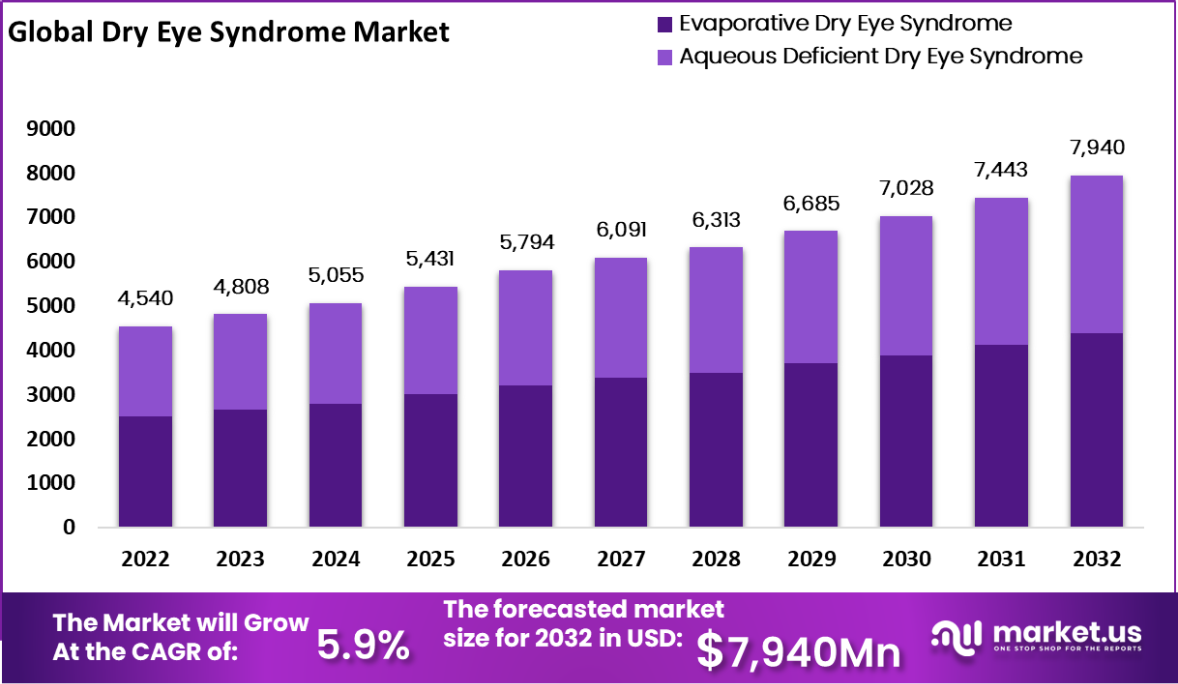Dry Eye Syndrome Market To Reach USD 7940 Mn By 2032

Market Size
Published Via 11Press : Dry Eye Syndrome is a common condition that affects millions of people worldwide. It occurs when the eyes do not produce enough tears or when the tears evaporate too quickly, leaving the eyes feeling dry, itchy, and irritated. This can be caused by various factors such as aging, hormonal changes, environmental factors like dry air or wind, certain medications, and underlying health conditions.
Global Dry Eye Syndrome market size is expected to be worth around USD 7,940 Mn by 2032 from USD 4,540 Mn in 2022, growing at a CAGR of 5.9% during the forecast period from 2023 to 2032.
In recent years, there has been a growing awareness of Dry Eye Syndrome in the medical community and among patients. This has led to an increase in research and development efforts to better understand this condition and find effective treatment options. Currently, there are several treatment approaches available for managing Dry Eye Syndrome including artificial tear drops, prescription eye drops that help reduce inflammation in the eyes, punctual plugs that block tear drainage channels to retain moisture on the surface of the eye, and lifestyle changes like using humidifiers or avoiding triggers such as smoke or excessive screen time.
The global market for Dry Eye Syndrome is expected to witness significant growth in the coming years due to the increasing prevalence of this condition and the rising demand for advanced treatment options. Additionally, technological advancements in diagnostic tools used for early detection of Dry Eye Syndrome are also contributing to market growth. However, challenges such as high costs associated with advanced treatments and lack of awareness about this condition in developing regions may hinder market expansion. Overall, understanding Dry Eye Syndrome is crucial for both healthcare professionals and patients alike in order to effectively manage this chronic condition and improve quality of life.

Request For Sample Report Here: https://market.us/report/dry-eye-syndrome-market/request-sample/
Key Takeaway
- The Dry Eye Syndrome market is expected to be worth approximately US$ 7,940 million by 2032, up from US$ 4808 million in 2023.
- This market is experiencing steady growth, with a Compound Annual Growth Rate (CAGR) of 5.9% from 2023 to 2032.
- Dry Eye Syndrome, also known as keratoconjunctivitis sicca (KCS), is a condition characterized by a lack of moisture or lubrication on the surface of the eye.
- Common symptoms of Dry Eye Syndrome include burning sensations, redness, itching, fatigue, photophobia (light sensitivity), and watery eyes.
- Factors contributing to the growth of the Dry Eye Syndrome market include a higher prevalence of the condition, a promising pipeline of treatments, and increased awareness among the public.
- The COVID-19 pandemic initially had a negative impact on the market as fewer people visited eye doctors, but it has since shown signs of recovery.
- Even after recovering from COVID-19, some patients continue to experience dry eye symptoms, leading to a larger population in need of treatment.
- The use of screens and sedentary activities during the pandemic has also contributed to an increase in dry eye symptoms.
- In 2023, evaporative dry eye syndrome was the most common type of Dry Eye Syndrome.
- Anti-inflammatory products were the best-selling category for Dry Eye Syndrome treatment in 2023.
- Eye drops were the preferred dosage form among patients in 2022 due to their ease of use.
- Over-the-counter (OTC) sales were the most profitable channel for Dry Eye Syndrome products in 2023.
- Hospital pharmacies dominated the distribution of Dry Eye Syndrome treatments in 2023.
- North America led the Dry Eye Syndrome market in 2023, accounting for 38.9% of the revenue.
- Asia-Pacific is expected to experience the fastest growth in the Dry Eye Syndrome market from 2024 to 2032.
- The growing elderly population and increased awareness are driving factors behind the rising cases of Dry Eye Syndrome.
- Contact lens usage is a common cause of Dry Eye Syndrome.
- Government support for medical research is allowing researchers to better understand and treat Dry Eye Syndrome.
- However, there are challenges, including a preference for self-medication, high treatment costs, competitive pricing, and stringent regulations.
- Rising investment in healthcare infrastructure is contributing to the growth of the Dry Eye Syndrome market.
- Research and development activities are increasing, leading to the development of new treatments.
- Major players in the market include Novartis AG, AbbVie Inc., Johnson & Johnson Services, and others.
- In January 2022, NovaBay Pharmaceuticals introduced Avenova lubricating eye drops to alleviate Dry Eye Syndrome symptoms.
Facts About Dry Eye Syndrome
- Dry Eye Syndrome (DES), a multifaceted condition impacting tear and ocular surface health, is associated with various symptoms including eye redness, intermittent blurry vision, and discomfort, especially for contact lens wearers. Over 86% of individuals with DES show signs of Meibomian Gland Dysfunction, highlighting the complexity of its etiology which involves both modifiable and non-modifiable risk factors. Non-modifiable risk factors identified include age, female sex, Asian race, and specific systemic conditions such as connective tissue diseases. Modifiable aspects range from environmental exposures to lifestyle choices like prolonged computer use and contact lens wear.
- The global prevalence of DES is noted to be approximately one in eleven people, underscoring its widespread nature. However, data for younger populations and certain geographical areas remain sparse. Interestingly, contact lens users have a notably higher predisposition to develop DES, with around 30% of the 140 million global contact lens wearers discontinuing use due to dryness and discomfort. Women, particularly those over age 50 and with autoimmune diseases, are more frequently diagnosed with DES, experiencing symptoms more severely and at a younger age compared to men.
- DES not only impacts quality of life but also has a significant economic and healthcare system burden, with costs for managing DES patients varying significantly across different regions. The indirect costs, particularly decreased work productivity, further emphasize the condition's impact on individuals and highlight the importance of comprehensive management strategies.
- Management approaches for DES are diverse, focusing on lifestyle modifications, environmental adjustments, and medical interventions, including the use of eye drops and eyelid cleansers. Education on the condition and its management is a critical first step, with treatment plans often tailored to individual patient needs. Despite the availability of treatments, DES remains a chronic condition that requires ongoing management to mitigate symptoms and prevent progression.
- Innovative Drug Treatments: The pharmaceutical pipeline for DES is robust, with over 50 drugs currently under development. Among these, two notable examples include Lotilaner 0.25% ophthalmic and perfluorohexyloctane (NOV03). Lotilaner, targeting Demodex mites associated with blepharitis, a contributing factor to DES, is expected to receive FDA approval. NOV03 is designed to treat DES caused by Meibomian gland dysfunction, focusing on stabilizing tear production and reducing tear evaporation.
- Microfluidic Contact Lenses: A groundbreaking approach involves the development of microfluidic contact lenses aimed at addressing contact lens-induced dry eye. This innovative solution could potentially revolutionize the way DES is managed for contact lens wearers, offering a direct, user-friendly treatment method.
- Anti-inflammatory and Immunomodulatory Therapies: Understanding the role of inflammatory mediators such as IL-1β, TNF-α, and IL-6 in the pathogenesis of DES has opened avenues for targeted anti-inflammatory and immunomodulatory therapies. These treatments focus on modulating the body's immune response to reduce inflammation on the ocular surface, offering a promising direction for future DES management strategies.
- Traditional Chinese Medicine (TCM): There's growing interest in exploring the efficacy of TCM in treating DES, with some studies suggesting potential benefits. This approach often involves using herbal formulations and acupuncture to address the underlying imbalances causing DES, marking a holistic alternative to conventional treatments.
- Technological and Therapeutic Advances: Other advancements include intense pulsed light therapy for reducing inflammation and improving Meibomian gland function, and the use of Tyrvaya, a prescription nasal spray that stimulates natural tear production. These options represent a diversification of treatment modalities, offering patients personalized approaches to managing DES.
The team behind market.us, marketresearch.biz, market.biz and more. Our purpose is to keep our customers ahead of the game with regard to the markets. They may fluctuate up or down, but we will help you to stay ahead of the curve in these market fluctuations. Our consistent growth and ability to deliver in-depth analyses and market insight has engaged genuine market players. They have faith in us to offer the data and information they require to make balanced and decisive marketing decisions.


